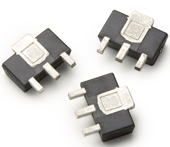
| Home | About Us | Contribute | Bookstore | Advertising | Subscribe for Free NOW! |
| News Archive | Features | Events | Recruitment | Directory |
News
3 September 2010
Avago launches SOT-89-packaged gain blocks for cellular infrastructure
 Enabled by its proprietary, 0.25µm GaAs enhancement-mode pHEMT process, Avago Technologies has launched four new gain block solutions that feature what is said to be high linearity, high gain, excellent gain flatness and low power dissipation.
Enabled by its proprietary, 0.25µm GaAs enhancement-mode pHEMT process, Avago Technologies has launched four new gain block solutions that feature what is said to be high linearity, high gain, excellent gain flatness and low power dissipation.
Avago’s newest power amplifier family is optimized for frequency in order to deliver better performance across major cellular frequency bands. The MGA-31189 and MGA-31389 serve applications from 50MHz to 2.0GHz and the MGA-31289 and MGA-31489 from 1.5GHz to 3.0GHz, so the MGA-31x89 series covers all major cellular bands — GSM, CDMA, and UMTS — plus next-generation LTE bands.
The family offers a choice of power levels in each pair of frequency-optimized devices: 0.25W for the MGA-31189 and MGA-31289 and 0.10W for the MGA-31389 and MGA-31489. The devices are designed with a common package footprint and pin-out, so a single PCB design supports multiple frequency bands and geographic markets with a choice of output power, simplifying PCB layout and overall design for system engineers developing new LTE band infrastructure. The devices also feature high gain, which can reduce the total number of RF stages needed.
Available in compact, industry-standard SOT-89 package, the MGA-31x89 0.25W and 0.10W gain block power amplifiers can also replace existing market solutions as a pin-to-pin, drop-in replacement, offering better linearity and power performance.
Typical features for the MGA-31189 and MGA-31389 (at 900MHz) are:
- linearity figure of merit1 (LFOM) of 14.5dB (MGA-31189) and 13.3dB (MGA-31389);
- high output third-order intercept-point of 42dBm (MGA-31189) and 38.6dBm (MGA-31389);
- high gain of 21dB (MGA-31189) and 21.3dB (MGA-31389);
- gain flatness over a 100MHz bandwidth of 0.1dB (MGA-31189) and 0.14dB (MGA-31389);
- low noise figure of 2dB (MGA-31189) an 2dB (MGA-31389);
- high output power at 1dB gain compression (P1dB) of 24dBm (MGA-31189) and 22.2dBm (MGA-31389); and
- low quiescent current (with single 5V supply) of 111mA (MGA-31189) and 73mA (MGA-31389).
Typical features for the MGA-31289 and MGA-31489 (at 1900MHz) are:
- linearity figure of merit1 of 14dB (MGA-31289) and 11.9dB (MGA-31489);
- high output third-order intercept-point of 41.8dBm (MGA-31289) and 37.2dBm (MGA-31489);
- high gain of 18.7dB (MGA-31289) and 21.3dB (MGA-31489);
- gain flatness over a 100MHz bandwidth of 0.1dB (MGA-31289) and 0.15dB (MGA-31489);
- low noise figure of 2dB (MGA-31289) and 2.1dB (MGA-31489);
- high output power at 1dB gain compression (P1dB) of 23.6dBm (MGA-31289) and 21.5dBm (MGA-31489); and
- low quiescent current (with single 5 V supply) of 124mA (MGA-31189) and 71mA (MGA-31389).
Along with a demonstration board, the devices are available now in an RoHS-compliant, halogen-free, SOT-89 plastic package with dimensions of 4.5mm x 4.1mm x 1.5mm.
![]() Search: Avago GaAs pHEMT
Search: Avago GaAs pHEMT
Visit: www.avagotech.com
For more Avago news: Latest issue of Semiconductor Today



